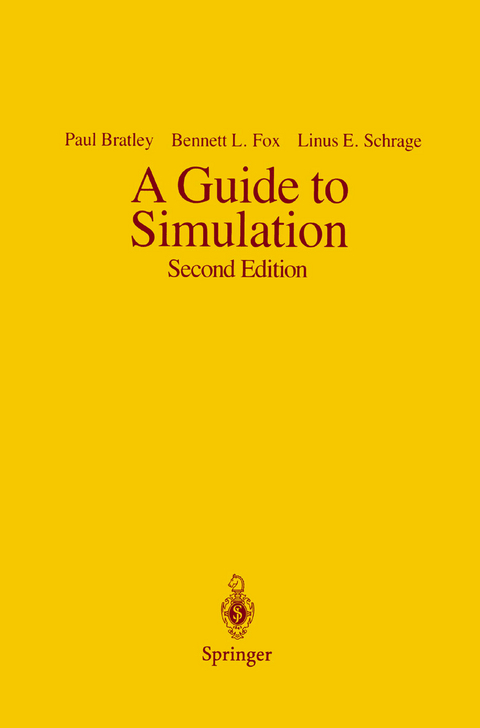
A Guide to Simulation
Springer-Verlag New York Inc.
978-1-4612-6457-6 (ISBN)
Changes and additions are sprinkled throughout. Among the significant new features are: • Markov-chain simulation (Sections 1. 3, 2. 6, 3. 6, 4. 3, 5. 4. 5, and 5. 5); • gradient estimation (Sections 1. 6, 2. 5, and 4. 9); • better handling of asynchronous observations (Sections 3. 3 and 3. 6); • radically updated treatment of indirect estimation (Section 3. 3); • new section on standardized time series (Section 3. 8); • better way to generate random integers (Section 6. 7. 1) and fractions (Appendix L, program UNIFL); • thirty-seven new problems plus improvements of old problems. Helpful comments by Peter Glynn, Barry Nelson, Lee Schruben, and Pierre Trudeau stimulated several changes. Our new random integer routine extends ideas of Aarni Perko. Our new random fraction routine implements Pierre L'Ecuyer's recommended composite generator and provides seeds to produce disjoint streams. We thank Springer-Verlag and its late editor, Walter Kaufmann-Bilhler, for inviting us to update the book for its second edition. Working with them has been a pleasure. Denise St-Michel again contributed invaluable text-editing assistance. Preface to the First Edition Simulation means driving a model of a system with suitable inputs and observing the corresponding outputs. It is widely applied in engineering, in business, and in the physical and social sciences.
1 Introduction.- 1.1. Systems, Models, and Simulation.- 1.2. Verification, Approximation, and Validation.- 1.3. States, Events, and Clocks.- 1.4. Simulation—Types and Examples.- 1.5. Introduction to Random Numbers.- 1.6. Perspective on Experimental Design and Estimation.- 1.7. Clock Mechanisms.- 1.8. Hints for Simulation Programming.- 1.9. Miscellaneous Problems.- 2 Variance Reduction.- 2.1. Common Random Numbers.- 2.2. Antithetic Variates.- 2.3. Control Variates.- 2.4. Stratification.- 2.5. Importance Sampling.- 2.6. Conditional Monte Carlo.- 2.7. Jackknifing.- 3 Output Analysis.- 3.1. Introduction.- 3.2. Analysis of Finite-Horizon Performance.- 3.3. Analysis of Steady-State Performance.- 3.4. Analysis of Transaction-Based Performance.- 3.5. Indirect Estimation via r = ?s.- 3.6. Problems.- 3.7. Renewal Theory Primer.- 3.8. Standardized Time Series.- 4 Rational Choice of Input Distributions.- 4.1. Addition and the Normal Distribution.- 4.2. Multiplication and the Lognormal.- 4.3. Memorylessness and the Exponential.- 4.4. Superposition, the Poisson, and the Exponential.- 4.5. Minimization and the Weibull Distribution.- 4.6. A Mixed Empirical and Exponential Distribution.- 4.7. Extreme Values and Spacings.- 4.8. When Not to Use a Theoretical Distribution.- 4.9. Nonstationary Poisson Processes.- 5 Nonuniform Random Numbers.- 5.1. Introduction.- 5.2. General Methods.- 5.3. Continuous Distributions.- 5.4. Discrete Distributions.- 5.5. Problems.- 5.6. Timings.- 6 Uniform Random Numbers.- 6.1. Random Introductory Remarks.- 6.2. What Constitutes Randomness.- 6.3. Classes of Generators.- 6.4. Choosing a Good Generator Based on Theoretical Considerations.- 6.5. Implementation of Uniform Random Number Generators.- 6.6. Empirical Testing of Uniform Random Number Generators.-6.7. Proper Use of a Uniform Random Number Generator.- 6.8. Exploiting Special Features of Uniform Generators.- 7 Simulation Programming.- 7.1. Simulation With General-Purpose Languages.- 7.2. Simscript.- 7.3. GPSS.- 7.4. Simula.- 7.5. General Considerations in Simulation Programming.- 8 Programming to Reduce the Variance.- 8.1. Choosing an Input Distribution.- 8.2. Common Random Numbers.- 8.3. Antithetic Variates.- 8.4. Control Variates.- 8.5. Stratified Sampling.- 8.6. Importance Sampling.- 8.7. Conditional Monte Carlo.- 8.8. Summary.- Appendix A The Shapiro—Wilk Test for Normality.- Appendix L Routines for Random Number Generation.- Appendix X Examples of Simulation Programming.- References.- Author Index.
| Zusatzinfo | XXI, 397 p. |
|---|---|
| Verlagsort | New York, NY |
| Sprache | englisch |
| Maße | 155 x 235 mm |
| Themenwelt | Schulbuch / Wörterbuch ► Lexikon / Chroniken |
| Informatik ► Grafik / Design ► Digitale Bildverarbeitung | |
| Mathematik / Informatik ► Informatik ► Theorie / Studium | |
| Mathematik / Informatik ► Mathematik ► Analysis | |
| Mathematik / Informatik ► Mathematik ► Arithmetik / Zahlentheorie | |
| Mathematik / Informatik ► Mathematik ► Wahrscheinlichkeit / Kombinatorik | |
| Wirtschaft ► Allgemeines / Lexika | |
| Wirtschaft ► Volkswirtschaftslehre | |
| Schlagworte | Simulation |
| ISBN-10 | 1-4612-6457-X / 146126457X |
| ISBN-13 | 978-1-4612-6457-6 / 9781461264576 |
| Zustand | Neuware |
| Informationen gemäß Produktsicherheitsverordnung (GPSR) | |
| Haben Sie eine Frage zum Produkt? |
aus dem Bereich


